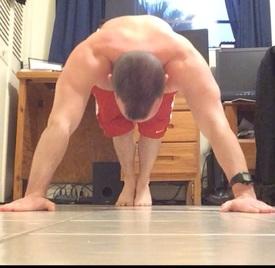Really dumb question!

SamanthaD1218
Posts: 303 Member
I just got a heart rate monitor for my birthday, and I'm kind of embarrassed to say that I have no idea how I'm supposed to use it (lol..). It didn't really come with instrutctions aside from how to turn it on and off. It measures calories burned, but what's the point of the heart monitoring piece? Just to see how high my heart rate is going? Is there an ideal heart rate range I should shoot for when doing cardio? I'm planning on doing some more research online, but I was just wondering how you all use yours.
Sorry for my ignorance!
Sorry for my ignorance!
0
Replies
-
Well it tracks how hard you are working out. An exercise with a 160 bom average is much more intense than an exercise with a 130 bpm average. That also means you are burning more calories. It's a good tool for knowing how hard you are working and if your are slacking.
Of course, it's not a perfect science because there are other things than can have your heart beating faster, but it still gives you a good idea of your exercise sessions.
As for heart rate zones, it depends on your age and objective. I personaly aim for a 170 bpm when running because I aim for performance (I'm a soccer player), but that is very intense.
HRM are very useful by the way What model did you get? 0
What model did you get? 0 -
Is it like a wrist-watch? If so, you're supposed to put your thumb and index finger on the frame......I think.0
-
Thank you for the info! That makes sense. I guess I'll have to do a little research to figure out where my bpm should be (I'm assuming it depends on my height/weight/age?). It looks like a watch - I don't have it with me at the moment so I'm not sure what model it is exactly. I also don't know how high quality it is, but if it seems like a good tool I might look into getting a nicer one. Thanks again!0
-
You can obtain the User's Manual by going to the manufacturer's website.0
-
Yes.but what's the point of the heart monitoring piece? Just to see how high my heart rate is going?
Ignorance is Phil Robertson. You just had questions.Is there an ideal heart rate range I should shoot for when doing cardio? I'm planning on doing some more research online, but I was just wondering how you all use yours.
Sorry for my ignorance!
There are specific heart rate zones that correlate to various types of workouts and perceived benefits. For example, low level aerobic might be heart rate zone 2, which for you will be different than for me. I did a two hour bike ride at that yesterday. Now my ride tomorrow will be straddling zones 3 and 4, which are significantly higher intensities and for different types of benefits.
Read the manual to learn to use it correctly. Then do a little research on heart rate zone training. For a while, just wearing it and reviewing the data will tell you a lot.0 -
If it does not have a chest strap to go with it to continually read your heart rate while exercising, you should swap it out for another that does. The wrist only type are not as accurate and will be (ultimately) a waste.
HRM are designed to read your heart rate and give you a calorie burn based on what your heart beat was for that time frame. They are not designed to be worn 24 hours a day, but during fitness activities. The more your beats during fitness, the more calories you burn. For me, this means more food to eat because the more I burn, the more I get to enjoy my meals and still lose weight.0 -
I have a HRM for Xmas too, no idea what kind.
Is yours just a watch, or does it have a chest strap too?
You might need to wear the strap and then it will tell you your heart rate as well as calories burned during exercise, more accurate than just accepting the default amounts in MFP or whichever site you're tracking exercise on0 -
You mentioned using your HRM for cardio...
The website link below explains the basics about heart rate zones, how to calculate your zones (multiple methods), and what the zones mean when working out. It's a good starting point.
http://wserver.flc.losrios.edu/~willson/fitns304/handouts/heartRates.html
HRMs are useful for all kinds of cardio exercises like cycling/spinning, running, and even high-intensity cardio classes like Zumba or kickboxing. If you get really into it, search for a heart rate zone training plan for your specific sport (like running or cycling).
I hope that helps!0 -
If it does not have a chest strap to go with it to continually read your heart rate while exercising, you should swap it out for another that does. The wrist only type are not as accurate and will be (ultimately) a waste.
Unless it's a good optical HRM. Like the Mio Alpha or Basis watch.0 -
Unless it's a good optical HRM. Like the Mio Alpha or Basis watch.
My friend has the Mio Alpha and she says it losses the heart beat to often to be effective. Her thought was that it is junk and maybe the second generation will be better. She returned it to get a Polar with chest strap.0 -
I just got mine, too. The one thing I suggest is you make sure you set your profile for your age and gender. I worked out like I'd never worked out before and was so disappointed it said I burned 39 calories! Turns out, if I were a 30 year-old male, I'd have burned 39 calories! Today, I burned a lot more since I set it correctly! ;-)0
-
Quick note about HRMs. They are designed to track your heart rate and determine calories burned, while doing "walking/running" style cardio. So the further you get away from that kind of exercise, the more inaccurate the monitor's calorie burn estimations might be.
For instance, if you're just doing pushups, it has no way of knowing and it's going to assume your elevated heartrate is due to leg work (larger muscles, used in a specific way, higher calorie burn) rather than arms and chest. Follow?
Just something to keep in mind, nothing to worry about or obsess over though.0
This discussion has been closed.
Categories
- All Categories
- 1.4M Health, Wellness and Goals
- 398.1K Introduce Yourself
- 44.7K Getting Started
- 261K Health and Weight Loss
- 176.4K Food and Nutrition
- 47.7K Recipes
- 233K Fitness and Exercise
- 462 Sleep, Mindfulness and Overall Wellness
- 6.5K Goal: Maintaining Weight
- 8.7K Goal: Gaining Weight and Body Building
- 153.5K Motivation and Support
- 8.4K Challenges
- 1.4K Debate Club
- 96.5K Chit-Chat
- 2.6K Fun and Games
- 4.8K MyFitnessPal Information
- 12 News and Announcements
- 21 MyFitnessPal Academy
- 1.5K Feature Suggestions and Ideas
- 3.2K MyFitnessPal Tech Support Questions








